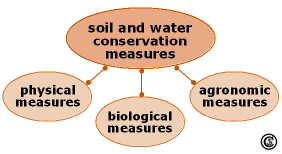Soil and Water Conservation Measures
Types of soil and water conservation measures
Image Credit: Anette Stumptner 2007 after Heathcote 1998, Krüger et al 1997.
Purpose of Soil and Water Conservation Measures
Soil and water conservation measures are predominantly applied for the following purposes:
- to control runoff and thus prevent loss of soil by soil erosion, to reduce soil compaction;
- to maintain or to improve soil fertility;
- to conserve or drain water;
- to harvest (excess) water [10].
Classification of Soil and Water Conservation Measures
A variety of soil and water conservation measures are well known. These technologies can be differentiated either by their main purpose or by type. As many among them fulfil several functions simultaneously these are classified here by type (see figure):
- physical measures (also termed mechanical or technical measures);
- biological measures (also termed vegetative measures);
- agronomic measures (sometimes called best management practices) [24].
Application of Soil and Water Conservation Measures
These measures are often used in combination, especially the many traditional soil and water conservation techniques. This is increasingly considered as reasonable. Merely technical approaches are often not successful, especially without participation of the local farmers, forest managers, etc. [18]. It has also been recognised that under modern circumstances traditional measures alone may often be insufficient to conserve the vital soil and water resources and have to be supplemented by modern practices to achieve a sustainable resource management [11].
The next pages will give you a short overview of the three types of soil and water conservation measures. Physical measures will be explained first of all.



